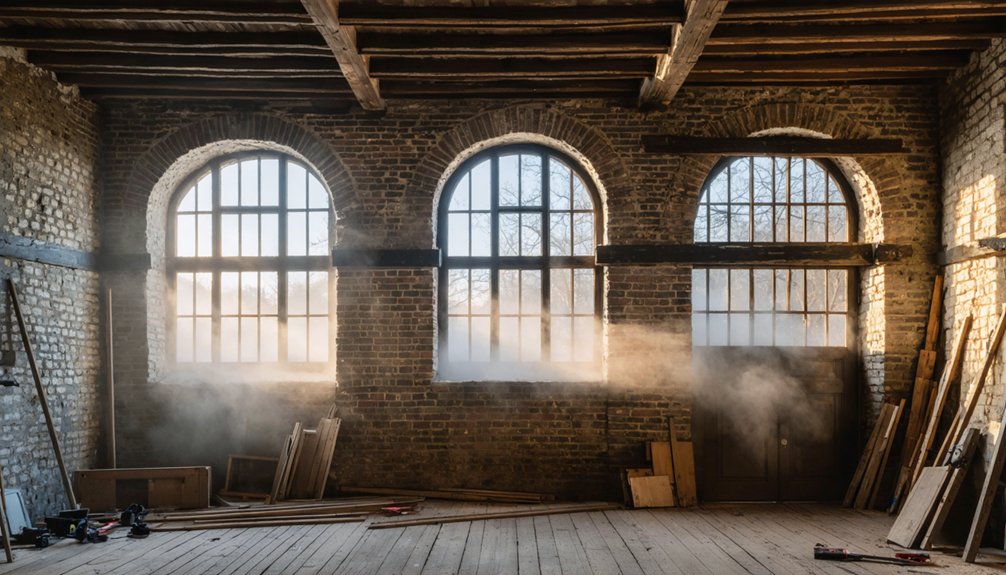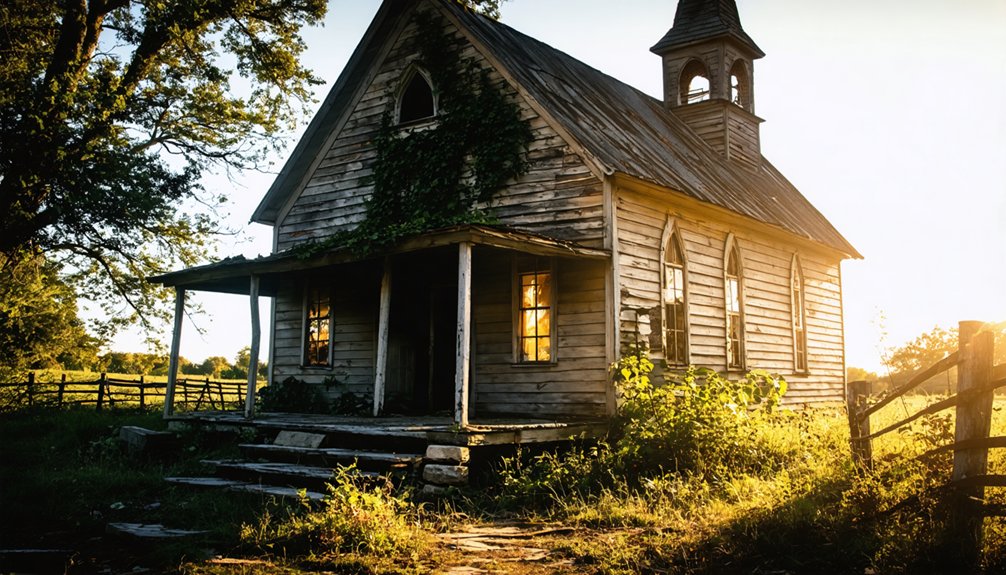America’s best-preserved ghost towns offer you authentic windows into our nation’s past. Bodie, California showcases the gold rush era with 2,000 original buildings. St. Elmo, Colorado maintains its mining heritage at 10,000 feet elevation. Kennecott, Alaska preserves an early 20th-century copper empire. Bannack, Montana features 60 structures from its days as territorial capital. Cahawba, Alabama reveals the ruins of a vanished state capital. These time capsules await your discovery with their remarkable stories.
Key Takeaways
- Bodie, California features over 2,000 preserved buildings with original artifacts in a protected state park.
- St. Elmo, Colorado maintains numerous original 1880s structures including hotels and stores at 10,000 feet elevation.
- Kennecott, Alaska preserves an entire copper mining complex with buildings showcasing early 20th-century industrial innovation.
- Bannack, Montana contains over 60 historic structures from its gold rush era as Montana’s first territorial capital.
- Cahawba, Alabama offers archaeological remnants of America’s most completely vanished state capital with foundation stones and brick ruins.
Bodie, California: Gold Rush Time Capsule in the Sierra Nevada
Hidden amidst the rugged terrain of the Sierra Nevada, Bodie stands as America’s quintessential gold rush ghost town, frozen in time since its 19th-century heyday.
Named after prospector William Bodey, who perished in a blizzard, the settlement’s spelling error was never corrected.
Bodie history transformed dramatically in 1876 when a mine cave-in revealed a rich gold vein, triggering a population explosion to 10,000 residents. The town developed a thriving China Town where hundreds of Chinese immigrants contributed to the local economy through various trades.
Fate struck gold in Bodie’s depths, transforming a modest camp into a boomtown practically overnight.
The town’s gold mining operations yielded an impressive $38 million in precious metals while earning notoriety as one of the West’s most lawless communities.
Today, visitors can freely explore over 2,000 preserved buildings containing original artifacts under state protection that prevents their removal.
St. Elmo, Colorado: Rocky Mountain Mining Legacy Frozen in Time
Perched at 10,000 feet elevation in Colorado’s majestic Sawatch Range, St. Elmo stands as one of America’s most remarkably preserved ghost towns. Founded in 1880 after a brief stint as “Forest City,” this mining boomtown once bustled with nearly 2,000 residents during its gold and silver heyday. The Mary Murphy Mine alone yielded over $60 million in gold.
Despite suffering a devastating fire in 1890 and the discontinuation of railroad service by 1922, St. Elmo’s mining heritage remains tangible through its well-preserved structures. The town’s haunting atmosphere is enhanced by local legends that Annabelle Stark’s ghost still watches over the property, protecting it from vandals.
You’ll find original buildings including hotels, stores, and the town hall—all virtually unchanged since the 1880s. Today, visitors can explore the 43 surviving structures including a beautifully restored schoolhouse that showcases the town’s educational past. Now listed on the National Register of Historic Places, this ghost town preservation success story offers visitors authentic glimpses into 19th-century frontier life through historical tours and immersive experiences among period furnishings and artifacts.
Kennecott, Alaska: Remote Copper Empire in the Wrangell Mountains
Deep within America’s largest national park lies Kennecott, a remarkably preserved copper mining complex that once ranked among the world’s richest mineral operations.
Operating from 1911 to 1938, this remote Alaskan outpost extracted over 4.6 million tons of ore, yielding 1.18 billion pounds of exceptionally pure copper.
For 27 years, Kennecott transformed Alaska’s wilderness into an industrial powerhouse, extracting vast mineral wealth from the frozen frontier.
The Guggenheim-Morgan controlled corporation constructed a 196-mile railway through harsh wilderness to transport their valuable cargo to port.
Today, you’ll find an unparalleled example of historic preservation, with original buildings, machinery, and artifacts standing almost untouched since operations ceased.
The National Park Service acquired the site in 1998 and maintains this National Historic Landmark within Wrangell-St. Elias National Park.
The mill town and five primary mines offer a glimpse into early 20th-century industrial innovation and the engineering feats accomplished in America’s last frontier. The tramway system that connected these mines showcased innovative engineering that transported ore using advanced cable systems. The discovery was initially made in the summer of 1900 when prospectors found rich malachite deposits along the Kennecott Glacier moraine.
Bannack, Montana: Territorial Capital Preserved in the Wild West
Once Montana’s first territorial capital, Bannack stands today as one of America’s most authentically preserved ghost towns, offering visitors a remarkably intact glimpse into the Wild West’s gold rush era.
Following John White’s gold discovery along Grasshopper Creek in 1862, Bannack history unfolded rapidly as the population swelled to 3,000 by spring 1863.
The town’s notorious sheriff Henry Plummer secretly led an outlaw gang, triggering the vigilante justice movement that defined Montana’s early days. The Vigilance Committee formed in December 1863 executed twenty-two individuals, including Plummer himself, in makeshift trials.
Though Bannack lost capital status to Virginia City in 1865 and gradually declined as larger gold deposits were discovered elsewhere, its significance endures.
Today, you’ll find over 60 historic structures—from gallows to the Hotel Meade—preserved as a National Historic Landmark where you can walk the same boardwalks as miners and outlaws once did. Visitors can experience the annual Bannack Days celebration on the third weekend of July, featuring historical reenactments that bring the ghost town’s past to life.
Cahawba, Alabama: The Vanished First Capital of the Deep South
Standing as America’s most completely vanished state capital, Cahawba tells a haunting story of rapid rise and total abandonment at the confluence of the Alabama and Cahaba rivers.
You’ll witness layers of Cahawba history as you explore this archaeological park, walking atop the remains of ancient Mississippian civilization beneath Alabama’s first state capital. Founded in 1818, Cahawba quickly grew to 1,000 residents before political maneuvering and flood concerns prompted the capital’s relocation to Tuscaloosa in 1826.
The town persisted until the Civil War, when it housed thousands of Union prisoners in deplorable conditions. Following the war, a massive February 1865 flood devastated the town, causing extensive damage to its remaining structures.
After losing its county seat status to Selma in 1866, Cahawba experienced a dramatic population decline that accelerated its journey to becoming a ghost town.
Today, this archaeological significance is preserved in crumbling brick ruins, grassy streets, and foundation stones. The site’s dual heritage—as both Native American center and lost American capital—offers a powerful reminder of civilization’s impermanence.
Frequently Asked Questions
How Accessible Are These Ghost Towns During Winter Months?
Winter accessibility varies greatly. You’ll find remote ghost towns often inaccessible due to snow-blocked roads, while lower-elevation sites remain open year-round. Always check conditions before planning winter ghost town visits.
Are Overnight Stays Permitted in Any of These Historic Towns?
You’ll find ghost town lodging options at Central Mine’s restored miners’ houses and Calico’s bunkhouse/campground, while Bodie prohibits overnight accommodations to preserve its arrested decay status.
What Wildlife Hazards Should Visitors Be Aware Of?
Beware the buzzing and biting threats during wildlife encounters. You’ll need to watch for venomous snakes, scorpions, feral canines, bats, and contaminated areas. Take safety precautions like proper clothing and avoiding disturbed structures.
Can Metal Detectors Be Used at These Historic Sites?
Metal detecting is generally prohibited at historic ghost towns without explicit permission. You’ll need to respect metal detecting regulations designed for historical artifacts preservation while seeking proper authorization from landowners.
How Do Preservation Efforts Impact Authentic Experiences for Visitors?
Like stepping into a time capsule, you’ll experience enhanced visitor engagement through preservation techniques that maintain authentic abandoned appearances while allowing safe exploration, without modernization that would diminish the site’s historical integrity.
References
- https://nightofthejack.com/2025/01/23/top-creepy-ghost-towns-in-america/
- https://en.wikipedia.org/wiki/Wikipedia:WikiProject_Ghost_towns
- https://optingoutofnormal.com/2023/07/26/exploring-americas-abandoned-gems-our-top-31-favorite-ghost-towns-to-visit/
- https://freepages.rootsweb.com/~gtusa/history/
- https://www.christywanders.com/2024/08/top-ghost-towns-for-history-buffs.html
- https://www.atlasobscura.com/lists/americas-best-preserved-ghost-towns
- https://www.geotab.com/ghost-towns/
- https://noospheregeologic.com/blog/tag/ghost-towns/
- https://www.visittheusa.com/experience/5-us-ghost-towns-you-must-see
- http://freepages.rootsweb.com/~gtusa/history/



